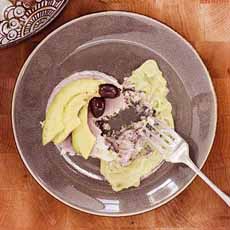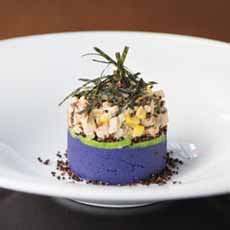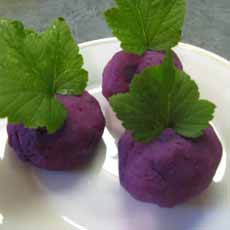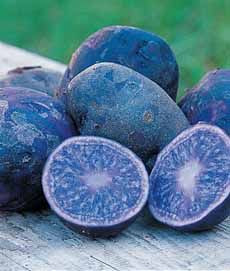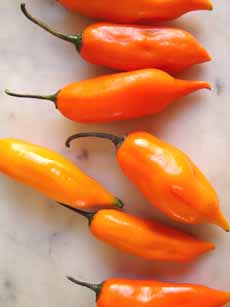Causa Morada Recipe Peruvian Chicken Salad: Get Creative With A Basic Recipe
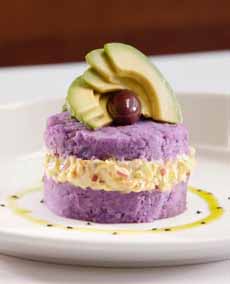 [1] Glamorizing potatoes and chicken salad. Here’s the recipe (photo © Potato Goodness).
|
Causa morada is a South American classic, a layered dish of potato-and-chicken salad. (The fancy layering in photo #1 is restaurant style. At home, layering is more casual.)
It is served chilled or at room temperature as an appetizer or as a lunch entrée. Make the mashed potatoes with purple Peruvian potatoes (photo #6), and you’ve got a dish that screams “Easter week!” You can substitute other salads (crab, egg, shrimp, tuna) and add other touches as you wish. We’ve included some variations below. The name of the dish comes from the Quechua* word kausay, which means “life” or “sustenance of life.” Potatoes originated in Peru and number hundreds of cultivars. They were the sustenance of life in pre-Hispanic Peru, as rice was in China. Morada means purple, referring to the purple potatoes. As you can see in Photo #7 below, there are also blue potatoes. The original dish was simply boiled potatoes eaten with slices of aji amarillo (the principal Peruvian chili). Meat was scarce in the Andes Mountains. Much of the cuisine was vegetarian. This most basic recipe of boiled potatoes illustrates today’s tip: The simplest foods can be made more flavorful and appealing, with a few twists. The recipe below is Adina, a modern Peruvian restaurant in Portland, Oregon. Peruvian cuisine is an interesting fusion, not just of Spanish and Inca cuisines, but of Japanese cuisine, from the immigration of Japanese laborers at the turn of the [20th] century. You’ll see how Japanese touches grace some of the variations. This recipe came to us via Potato Goodness, the recipe website of Potatoes USA, the nation’s potato marketing and research organization. > The different types of potatoes. Ingredients For 6 Servings 1. PLACE the potatoes in a large saucepan, cover with cold salted water, and bring to a boil. Reduce the heat and simmer until very tender, about 20 minutes. Let cool. 2. PEEL the potatoes and pass them through a food mill or ricer (or simply mash very finely) into a large bowl. Knead lightly with gloved‡ hands, slowly drizzling in oil, as needed, to a dough-like consistency. Add the lime juice and season to taste with salt. Refrigerate until cold and firm, about 2 hours. 3. PLACE the chicken, onion, carrot, and mint into a large saucepan, adding just enough water to cover. Bring to a slow boil. Cook until the chicken is fork tender and can be pulled apart, about 20 minutes. 4. TRANSFER the chicken to a medium bowl. Once cool enough to handle, shred with fingers or a fork. Mix in the mayonnaise, aji amarillo, celery, and red onion. Season to taste with salt and pepper. Refrigerate until cold, about 1 hour. 5a. For individual servings, layer ring molds with potato mixture, then chicken mixture, then potato mixture. Refrigerate until firm, about 2 hours. 5b: For a single dish, use a 2-quart glass casserole. Layer the ingredients, as above. Refrigerate until ready to serve; let warm to room temperature first, as desired. |
|
|
HOW TO CHANGE IT UP
Color: Purple or blue potatoes add so much more punch to Causa Morada than white varieties. As another example, how about a yellow gazpacho, using yellow tomatoes and bell peppers instead of the conventional red? Size: Turn a full dish or side into an appetizer: Causa Morada bites (chicken salad stuffed into baby potatoes) or gazpacho shots? Or gazpacho sorbet? Format: Change the shape and purpose, like the plated Causa Morada in photo #2, the croquettes in photo #4, and the appetizers in photo #5. Can you turn it into a drink? You can make a Caprese Cocktail by reformatting the ingredients of Caprese Salad: a mix of tomato and lettuce juices, with a garnish of mozzarella balls on a pick. Another ingredient: The avocado in photo #1 adds new personality to the dish. What about a surf and turf variation, adding something from the sea (scallops? shrimp?). Crunch: If the dish has no crunch, add some. Anything from a side of jicama batons or radish slices to an artisan cracker or potato plantain chip on top, will do the trick. One of our secrets: Japanese rice cracker snack mix, which is also one of our favorite things to serve with wine and cocktails. Sweetness: Add some fruit, minced into the chicken salad, grilled as an extra layer or garnish, or pureéd into a sauce. Salty: Blend in olives or capers, for example. Condiments: Add chutney; cornichons or gherkins; pickled vegetables; or relish to the plate. Vegetables: For Causa Morada, some red color cherry or grape tomatoes, or some texture a bit of frisée or arugula salad. Sauce: There are countless types of sauces for every dish. Sweet, savory, herbal, matching, contrasting. Bread: Could bread or crackers enhance the dish? For example, Causa Morada could be served with toasts or flatbread on which to spread the soft layers. Consider what would enhance your recipe: anything from garlic crostini (garlic bread) to sesame breadsticks to Garnish: Garnish can change the personality of a dish. Imagine Causa Morada topped with julienned nori (photo #3), honey peanuts, diced melon, and shoestring fried onions. For fun: a few Goldfish? ________________ *Quechua is the language of the Incas. It is still spoken by their ancestors in the Andes Mountains. †You can substitute other fresh chile. If you don’t want to take the time to purée the chile, just add minced pieces to the chicken salad.
|
|
|
|
|
||
